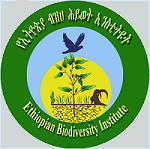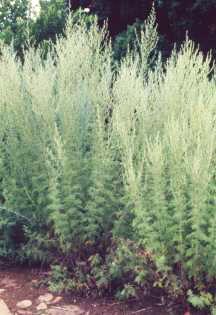 Identification of Artemisia afra for Access and Benefit Sharing activities
Identification of Artemisia afra for Access and Benefit Sharing activities
|
Genetic Resources Access and Benefit Sharing Directorate Identification of Artemisia afra for Access and Benefit Sharing activities Reviewed by Abiyselassie Mulatu
Artemisia afra May 2016 1. Introduction Ethiopia, which is rich in biological diversity, may hope to earn profit or make economic gains from its Plant, Animal and Microbial Genetic Resources. The country expects from bioprospecting of direct financial benefits of these genetic resources. There are evidences in the least megadiverse countries, where more access to Genetic Resources has been made for commercial purposes, whereas there are little attempts in the most megadiverse country of ours. Therefore, a setting is developed to identify the well-researched genetic resources of the country and advertise them to any bioprospectors. For this, Ethiopia has issued proclamation on Access to genetic Resources and Community Knowledge and Community Rights (Proclamation No 482/2006) and Regulation 169/2009. Based on these frameworks, the country has been implementing the access and benefit sharing objective of the Convention on Biological Diversity (CBD). The Proclamation includes a range of issues such as ownership, user rights, and conditions for access, benefit sharing, types of benefits, powers and responsibilities among the others. The law bears the necessity of prior informed consent (PIC) to access genetic resources or community knowledge. Following PIC, the Institute including relevant stakeholders negotiates on mutual agreed terms (MAT) with the user of the genetic resource. Therefore this call is intended to encourage any bioprospecting company or an individual who is interested to work on Artemisia afra (Artemisia abyssinica) of Ethiopia: 2. Taxonomy and Plant description of Artemisia afra and Artemisia rehan Artemisia afra Jacq., commonly known as the African wormwood, belongs to the family Compositae (Asteracea). It is one of the most widely used southern African medicinal plant with essential oil components (Esteban et al., 1986; Graven et al., 1990). Indigenous people of Ethiopia (Bale) refer to Artemisia afra as 'Chigugn' (Amharic), Kapani (Oromgna), Kodo (Guragna). It is an evergreen perennial herb or deciduous subshrub with grey or green foliage leaves containing yellow florets. It is aromatic and it exudes a pungent, sweet smell when any part of the plant is bruised. It grows up to a height of about 1 meter, at an altitude range of 3070 and 3600metres a.s.l. (Mesfin Tadesse and Sebsebe Demissew, 1992). 3. Geographical distribution of Artemisia afra Artemisia afra Jacq., is found throughout Africa as a common species in the southern, central and eastern Africa and extends as far north as Ethiopia. In Ethiopia, this plant is found in Bale, Sidamo, Arba Minch and Keffa (Mesfin Tadesse and Sebsebe Demissew, 1992). It usually grows in rocky mountainous areas along forest margins and stream sides and its natural distribution extends from Bale mountains National Park (Dinsho) southeastern Ethiopia to northern parts of Ethiopia (Dawit Abebe, 1986). 4. Ethnomedical use of Artemisia afra Artemisia afra has a long history of domestic herbal use in both the Northern and Southern parts of Ethiopia. Juice of chopped leaves of A. afra mixed with water is traditionally taken orally for the treatment of roundworm and stomach pains in the Bale area of Ethiopia. The leaves are also chewed or the aroma is inhaled for stomachaches and headaches (Menassie Gashaw, 1991). Charred powder of leaves mixed with honey or edible oil is also used as remedies for eye diseases (crying eyes and cataract) and stomach cramps by the Northern people of Ethiopia. Leaf tea of this plant is used to treat coughs, colds and flu as well as bronchial and intestinal ailments. Milk decoctions of the whole plant or leaves are used in the treatment of haematuria, haemorrhoids, mumps, small pox, malaria, neuralgia, colitis and liver disorders. The plant also has tonic, stimulant, perfumic, antihelmintic (vermifuge) and antipyretic (febrifuge) properties (Jansen, 1981; Dawit Abebe and Ahadu Ayehu, 1993; Iwu, 1993). 5. Scientific researches on Artemisia species and Artemisia afra In the 1970's it was found that Artemisia annua contains an active principle, artemisinin, a novel antimalarial agent which have been shown to be potent against Plasmodium falciparum in vitro and in vivo (Klayman, 1993 cited in Phillipson, 1999). Crude ethanol extracts of aerial parts of this Artemisia species and some sesquiterpene lactones isolated from it were found to have antiulcerogenic property (Dias et al., 2001; Foglio et al., 2002). In the previous studies, plant extracts of A. afra were studied for antihelmintic property by Berhanu Abegaz and Ermias Dagne (1979). Butanol extracts of A. afra were tested to be positive for anti-implantation effect but negative for uterotonic effect. On the other hand, the aqueous and ethanol extracts of the plant were tested to be negative for both uterotonic and anti-implantation effects (Belachew Desta, 1994). Moges Kassa et al. (1998) had reported about the in vitro anti-malarial activity of the crude extracts from the aerial parts of this plant. Aqueous A. afra extract had a hypertensive effect in vivo and a dose-dependent biphasic effect on the heart in vitro suggesting its potential use for the management of hypertensive conditions (Guantai and Addae-Mensah, 1999). The antimicrobial property of A. afra has also been documented by Mangena and Muyima (1999). The plant material has been shown to be devoid of acute toxic effects (Guantai, 1990 cited in Guantai and Addae-Mensah, 1999). The antioxidant (potential free radical scaveniging) activities of this plant along with A. abyssinica were examined by Burtis et al. (2001). Until now research studies with A. rehan were largely concentrated on the antimalarial activity (Moges Kassa et al., 1998). Moges Kassa et al. (2001) carried out in vitro cytotoxic tests of this antimalarial plant along with A. afra against a human leukemia monocyte cell line and the extracts of these plants at 0.23-23 mg/ml concentrations in vivo were proved to be not cytotoxic. Artemisia afra leaf ethanol (ALE) and Artemisia rehan leaf ethanol (RLE) were found to significantly reduce both spontaneous rhythmic and agonist-induced contractions of mouse duodenum and guinea pig ileum which suggests the spasmolytic property of the plants and recommends the traditional folk use of the aerial and root parts of the plants for stomach pains and intestinal cramps (Abiyselassie Mulatu and Yalemteshay Mekonnen, 2007). The acute and subchronic toxic effects of leaves of Artemisia afra on liver and kidney; and some blood parameters in rats were investigated and found to be relatively safe (Nikodimos Eshetu, 2015). 6. Pharmacological potential and compounds isolated from Artemisia afra Alpha-thujone, beta-thujone, 1,8-cineole and camphor were reported as the major constituents of A. afra from South Africa. On the other hand, yomogi alcohol and artemisia alcohol acetate were reported to be the two major constituents of Ethiopian origin (Graven et al., 1990; Tadele Worku and Rubiolo, 1996). Previous works on the essential oil of A. rehan from Ethiopia revealed camphor and denavonone as major constituents (Berhanu Abegaz and Paulos G.Yohannes, 1982). The green parts of A. rehan Chiov. were found to contain vulgarin which is proved to be identical with compounds such as barrellin and judaicin (Berhanu Abegaz et al., 1986).
References Abiyselassie Mulatu and Yalemtsehay Mekonnen (2007). Spasmolytic effects of Artemisia afra and Artemisia rehan in tissue preparations. Ethiop. Med. J. 45(4):371-376. Belachew Desta (1994). Ethiopian traditional herbal drugs. Part III: Antifertility activity of 70 Medicinal Plants. J.Ethnopharmacol. 44: 199-209. Berhanu Abegaz and Ermias Dagne (1979). Comparative bioassay studies of traditional antihelmintic plants, plant extracts & modern drugs. SINET: Ethiop.J.Sci. 1(2): 117-122. Berhanu Abegaz and Paulos G.Yohannes (1982). Constituents of the essential oil of Artemisia rehan. Phytochemistry: International Journal of Plant Biochemistry 21(7): 1791-1793. Berhanu Abegaz, Camps, F., Coll, J., Feliz, M., Jacobson, U., Miravitlles, C., Molins, E. and Torramilans, J. (1986). The structure of vulgarin and its isomers - A reinvestigation. Tetrahedron 42 (21): 6003-6009. Burtis, M., Kaleab Asres, and Bukar, F. (2001). The antioxidant activity of the essential oils of Artemisia afra, Artemisia abyssinica Schultz.Bip. and Juniperus procera. Phytother.Res. 15 (2): 103-108. Dawit Abebe (1986). Traditional Medicine in Ethiopia, The attempts being made to promote it for effective and better utilization. Ethnobiol and Ethnomedic J. 9:61-69. Dawit Abebe and Ahadu Ayehu (1993). Medicinal plants and Enigmatic Health Practices of Northern Ethiopia. B.S.P.E. Addis Ababa. Ethiopia. Dias, P.C., Foglio, M.A., Possenti, A., Nogueira, F. and Carvalho, J.Ed. (2001). Antiulcerogenic activity of crude ethanol extract and some fractions obtained from aerial part of Artemisia annua L. Phytother. Res. 15(8): 670-675. Esteban, M.D., Collado, I.G., Macias, F.A., Massanet, G.M., and Luis, F.R. (1986). Flavonoids from Artemisia lantana. Phytochemistry 25: 1502-1504. Foglio, M.A., Dias, P.C., Antonio, M.A., Possenti, A., Rodrigues, R.A.F., Silva, E.F.D., Rehder, V.L.G., and Carvalho, J.Ed. (2002). Antiulcerogenic activity of some Sesquiterpene Lactones isolated from Artemisia annua. Planta Medica 68(6): 515-518. Graven, E.H., Webber, L., Venter, M., and Gardner, J.B. (1990). The Development of Artemisia Afra (Jacq.) as a new essential oil crop. J.Essent.Oil. Res. 2:215-220. Guantai, A.N., and Addae-Mensah, I. (1999). Cardiovascular effect of Artemisia afra and its constituents. Pharmaceutical Biology 37(5): 351-356. Iwu, M.M. (1993). Handbook of African Medicinal plants. CRC press. Inc. London. Tokyo. Jansen, P.C.M. (1981). Spices, condiments and Medicinal Plants in Ethiopia: Their taxonomy and agricultural significance centre for Agricultural Publishing and Documentation. Wageningen, The Netherlands. Mangena, T. and Muyima N.Y.O. (1999). Comparative evaluation of antimicrobial activities of essential oils of Artemisia afra, Pteronia incana, and Rosmannus officinalis on selected bacteria and yeast strains. Letters in Applied Microbiology 28 (4): 291-296. Menassie Gashaw (1991). The use and value of wild plants to the people of Bale. Walia 13: 21-28. Mesfin Tadesse and Sebsebe Demissew (1992). Medicinal Ethiopian Plants. Inventory, identification and classification. In: Plants used in African traditional medicine as practiced in Ethiopia and Uganda (Edwards, S. and Zemede Asfaw, eds.) Botany 2000, east and Central Africa, NAPRECA, Monograph Series, No.5, Published by NAPRECA, Addis Ababa University, Addis Ababa, Ethiopia. Moges Kassa, Robert Mshana, Azeb Regassa and Getachew Assefa (1998). In vitro test of 5 Ethiopian Medicinal plants for antimalarial activity against Plasmodium falciparum. SINET: Ethiop. J.Sci. 21(1): 81-89. Nikodimos Eshetu (2015). Evaluation of the acute and sub-chronic toxic effects of aqueous leaves extracts of Artemisia afra on Liver, Kidney and some Blood parameters in Wistar Rats at Addis Ababa University on year 2014/2015. MSc Thesis. Addis Ababa University, Addis Ababa, Ethiopia. Tadele Worku and Rubiolo, P. (1996). Major constituents of Artemisia afra oil. J.Essent. Oil. Res. 8(4): 355-357. |
| Release date | 19/07/2016 |
|---|---|
| Contributor | IT Team EBI |
| Geographical coverage | Identification of Artemisia afra for Access and Benefit Sharing activities |
| Keywords | Artemisia afra |
Please note that this information has expired.

